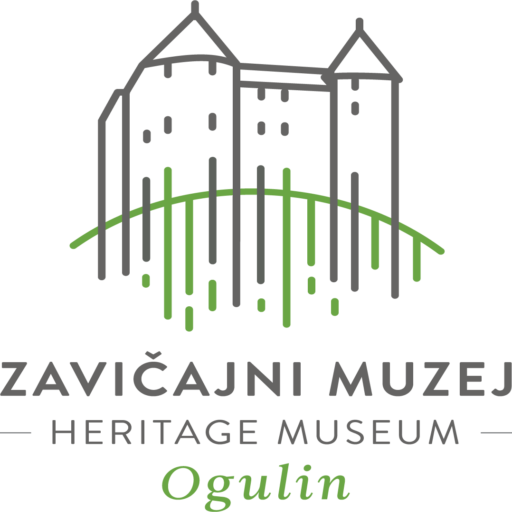NARODNA NOŠNJA OGULINSKOG KRAJA
Ženska narodna nošnja je u osnovi trodjelna i sastoji se od košuljka, suknje s poramenicama u obliku prslučića i zaslona od svile ili pamuka. Suknja s poramenicam ima tri varijante: kambrik izrađen od tanjeg pamučnog industrijski rađenog platna, mrčina izrađena od vunenog tvorničkog materijala i tzv. šara kiklja od štampanog pamučnog materijala.
Ženska nošnja uključuje i tkanicu, pojas istkan od predene i bojane vune, pletene pamučne čarape, a od obuće su se nosili opanci kapičari, pletene papuče lokvarke i polucipele s nižom petom.
U zimsko doba preko mrčine se nosilo bluzu i podstavljeni kaputić, a preko svega se ogrtalo vunenim debelim rupcem s dužim sukanim resama.
Kosu su žene i djevojke plele u pletenice smotane u punđu na zatiljku i pokrivale pamučnim ili svilenim rupcem.
Do kraja 19.stoljeća nosilo se podvezak i tumban, koji su u 20. stoljeću obnovljeni i nošeni samo u svečanim prigodama uz kambrik i svileni zaslon.
Osnovni dijelovi muške ljetne i zimske nošnje krojem i izborom materijala identični su narodnoj nošnji susjedne Like. Platnena košulja i gaće stegnute čemerom, ječerma, opanci kapičari i lička crvenkapa čine glavne dijelove muške narodne nošnje ogulinskog kraja, koja se nosila ljeti i zimi kao svečana nošnja. Zimi se nosilo suknene hlače, kaput haljinac i pletenu maju, koji do danas nisu sačuvani.
Zanimljivo je kako se u narodnoj nošnji ogulinskog kraja ogledaju davni utjecaji japodske materijalne kulture: u narodnoj nošnji čiji su sastavni dijelovi tkanica (dio ženske nošnje) te kapa i široki kožnati pojas čemer (dijelovi muške narodne nošnje).
Nošnja se relativno rano, već početkom 20. stoljeća, prestala nositi kao svakodnevna odjeća, da bi potpuno nestala u razdoblju neposredno nakon II. svjetskog rata. Zato nije potpuno sačuvana do danas.
U današnje vrijeme opisana narodna nošnja ogulinskog kraja predstavlja kostim za scenski nastup i prezentaciju u svečanim prigodama, gdje predstavlja dio tradicijske baštine.
/ENG/
NATIONAL COSTUME OF THE OGULIN AREA
Women’s national costume is basically three-part and consists of a shirt, a skirt with straps in the form of a vest and an apron made of silk or cotton. The skirt with straps has three variants: kambrik made of thin industrial fabric, mrčina made of woollen manufacturing material and the so-called šara kiklja made of printed cotton material.
The women’s costume includes tkanica, a belt woven of spun and dyed wool, knitted cotton socks, and the footwear included kapičari sandals, knitted lokvarka slippers and shoes with a lower heel.
In winter, a blouse and a padded coat were worn over mrčina, and a thick woollen scarf with longer woven fringes was wrapped at the top of everything.
Women and girls braided their hair into a bun on the back of the head and covered it with a cotton or silk scarf.
Until the end of the 19th century, podvezak and tumban were worn, which were restored in the 20th century and worn only on festive occasions with kambrik and a silk apron.
The basic parts of the men’s summer and winter costume are identical to the national costume of neighbouring Lika in terms of cut and choice of materials. Linen shirt and trousers fastened with čemer, ječerma, kapičari sandals and Lika’s crvenkapa are the main parts of the men’s national costume of the Ogulin area, which was worn in summer and winter as a ceremonial costume. In winter, cloth pants, haljinac coat and a knitted maja were worn, which have not been preserved to this day.
It is interesting how ancient influences of Japod material culture are reflected in the national costume of the Ogulin area: in the national costume, the components of which are tkanica (part of the women’s costume) and the cap and the wide leather belt called čemer (parts of the men’s national costume).
The costume stopped being worn as everyday clothing relatively early, at the beginning of the 20th century, and disappeared completely in the period immediately after World War II. That is why it has not been completely preserved to this day.
Nowadays, the described national costume of the Ogulin area is a costume for stage performance and presentation on festive occasions, where it represents part of the traditional heritage.



